
PBX Networking | Configuration |
|
|
9.2Configuration
The possible configurations described below can be set up in the Web console using the Telephony: Trunks menu.
9.2.1 Bundles
A bundle is a group of lines of the same type and direction. A line can only be assigned to one bundle.
Network operator
A
B
PBX 1
C
PBX 2
PBX 3
E
D
Bundle
SIP trunk
Example of a PBX network with bundles
In the above example, the following bundles are configured for PBX 1:
■Two SIP trunks to the network operator which are assigned to the “A” bundle.
■Two
■One
Note: A line or a bundle cannot be seized directly. It is al- ways performed indirectly via a route.
9.2.2 Routes
A route is a group of bundles enabling a connection in one direction. If the first bundle of a route is fully utilized, the next bundle is seized (“bundle overflow”). One bundle can also be used for different routes.
In the above example, a route set up for PBX 1 allows a connection to PBX 2. Bundle “C,” “E” and “A” are assigned to this route. If a user connected to PBX 1 wants to reach a party in PBX 2, lines will be seized in the following order:
■PBX 1 first searches for a free channel in the “C” bundle.
94
